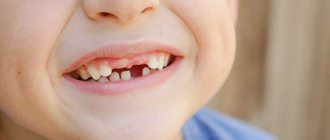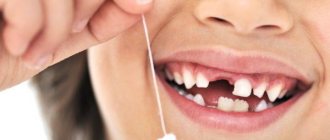Mom and dad can't wait for their child's baby teeth to begin to be replaced by molars. Such changes always raise a lot of questions. Usually molars grow without difficulty, but there is always a risk of complications. You can avoid possible unpleasant consequences if you regularly visit the pediatric dentist. The dental clinics of the Stomus network employ experienced and qualified specialists who can identify teething difficulties and help cope with them.
Features of teething
Teething can be painless, without disturbing the baby’s well-being or changing his behavior. However, in most cases, this process is accompanied by hyperemia, fever, refusal to eat and many other symptoms.
At this stage of child development, all dads, and especially moms, need to be patient and prepare themselves for the fact that the period of teething may be accompanied by severe symptoms.
Modern parents are very worried about this problem, so they try to carefully read the necessary literature, learn from the experience of relatives, in order to prepare for the appearance of the first incisor. More often, mothers find plans that provide the required number of teeth at a given period of age, and if there are no expected results within the specified period, they begin to panic.
Is it possible to know in advance which tooth will make itself known first? In what order do children's teeth appear? It is quite difficult to answer questions with accuracy, since each organism is special and its development occurs in its own way.
When does a child's molars come out?
Growing permanent teeth is a big job for the body, which we rarely notice. Changes begin at 3 years - the rudiments of molars are formed. At age 5, noticeable gaps appear between the baby teeth to make room for new “tenants.”
Which teeth come out first is determined by a lottery - genetics. In half of the cases, growth begins with “sixes”. Molars grow by the age of 7-8 years, at the same time the front incisors change.
Teeth grow slowly but painlessly. At 14, the main bite is already formed. “Late” wisdom teeth - third molars grow in a few years, at 18-21 in most adults.
Teething order
Diagram of the eruption of baby teeth (numbered in order of priority)
Finding out the sequence of teeth appearance in children will be useful for young parents who have already felt the joy of becoming a mother and father, or this is still to come in the future. By the end of the first year, children have several teeth. The number is determined by a number of factors. One reason is heredity.
Problems in the baby’s body that arise as a result of:
- low calcium content in the body and the formation of rickets.
- dysfunction of the thyroid gland and, as a result, a decrease in hormones in the blood.
- absence of incisors (edentia).
- dysfunction of the gastrointestinal tract.
Baby teeth
While still in the womb, the rudiments of dental formations are formed in the fetus. And by the middle of pregnancy, the required number and order of appearance of one or another incisor is formed.
It must be taken into account that a child’s oral bone formations should number 20. The time of eruption of baby teeth and the order are of a purely individual nature. However, there are generally accepted norms, which are an indicator of the correct physiological development of the baby. So how do children usually grow their teeth? Let's take a closer look at this topic.
First tooth
In babies, the first pair of teeth appears on the lower jaw. Which tooth of a given pair should appear first? Pediatricians say that teeth can erupt at the same time or with an interval of several days. And you shouldn’t worry about which incisor appeared first, because there are no special rules for this. Usually, young parents are happy to see their child’s first tooth appear at 6-7 months of his life. But at the same time, the scope of the norm expands significantly - from 4 to 9 months.
Second pair
Following the growth of the lower incisors, the upper ones should appear. The order in which the right or left incisor appears first does not matter. The interval between their occurrence can vary from several hours to two weeks.
According to statistics, the upper incisor appears first on the side from which the lower one appeared. The upper teeth normally erupt at 5-11 months. Usually at eight months.
Third pair
How does a child’s teeth continue to grow? After the child begins to smile with his 4 teeth, his lateral incisors, which are located on the upper jaw, appear. The third pair of bone formations appears at 10 months. Medical experts consider it normal for these teeth to erupt from 7 months to a year.
Fourth pair
The lower lateral incisors appear between 9 and 15 months.
The child's next teeth are the upper and lower molars. Normally, they appear before the fangs. But in recent years, doctors have increasingly encountered exceptions when the canines form first. And after 2-3 months, the lower molars are also replenished in the mouth.
Molars begin to grow at the age of 1-1.5 years. Let us immediately note that molars are large formations and their eruption is accompanied by high fever, lack of appetite and capriciousness of the child.
The next stage of the teething scheme is given to the canines. Fangs usually appear between the ages of one and a half to two years. But there are cases when they are formed earlier than paired molars.
Fangs, like painters, make themselves felt through the manifestation of the following symptoms: pain and itching of the gums, symptoms of rhinitis, changes in stool. These signs disappear as soon as a new tooth appears.
The second group of upper and lower molars erupt painlessly and asymptomatically at 2-3 years. This group is the final one in the chain of primary (non-permanent) teeth. After the milky bone formations of the oral cavity begin to fall out, permanent teeth will grow.
Generally accepted teething pattern
Children at 2.5 years old should have 4 incisors and 4 molars, as well as 2 canines. This scheme looks like this: 2-1-2 (2 incisors, 1 canine, 2 molars grow from above and below from each half of the jaw).
In order to determine the normality of a child’s teeth, a special formula is provided. The calculation is carried out as follows: the number of teeth should correspond to the difference in the age of the baby in months and six. For example, at 1.5 years (17 months) this number is 11 (17-6=11). The method for determining the required number of teeth is more appropriate to use for children under two years of age, then the formula will be more accurate.
First teeth: symptoms of their eruption
The progress of teething is usually accompanied by certain symptoms. These signs are reflected in behavior and emotional state. The following manifestations are considered normal:
- secretion of saliva in large quantities. This symptom usually appears at the end of 2 months and can last up to 4.
- looseness and hyperemia of the gums – lasts for quite a long time.
- skin irritation in the lips and chin area. The appearance of an allergic reaction is caused by excessive salivation. To prevent irritation on the baby's delicate skin, parents should wipe his mouth more often and lubricate the skin with baby cream. For better absorption of the cream, it is better to apply it at night.
- The gums turn red and begin to itch. This manifests itself when the baby is breastfeeding, because he bites the nipple.
- the presence of pain disrupts the baby's sleep. For some time he will not be able to fall asleep on time, and the duration of sleep will be shorter. During this period, some pediatricians recommend giving the baby analgesics.
- Lack of appetite and refusal to eat are common problems during the teething stage. This symptom is caused by pain when eating food. The exception is the mother's breast.
- thumb sucking or the desire to chew on something. Most often, the child puts into his mouth any object that catches his eye and begins to gnaw on it. Therefore, it is necessary to ensure that toys and other items are clean.
- hematomas or bruises - medium-sized bulges on the gums with a bluish tint. There is no need to worry about their occurrence if their number is insignificant. You can apply cold compresses to the bumps. The hematomas will gradually disappear on their own.
All of the above signs have virtually no effect on the baby’s behavior and well-being, and disappear after teeth appear.
How to help a child with incisor teeth?
As soon as the baby begins to be bothered by the symptoms associated with the manifestation of incisors, parents begin to look for ways to eliminate negative phenomena. There are many tips and recommendations from specialists that can help you survive this stage of a child’s development more easily and without any consequences.
How can I make teething easier for my baby?
- You should provide your child with objects that he can chew on. This will relieve his anxiety and massage his gums.
- For this purpose, rubber toys filled with liquid or gel filler are best suited. They are designed to achieve a cooling effect on the gums. The main disadvantage of such items is that they will have to be periodically placed in the refrigerator.
- Pacifiers or bottles. The chewing or sucking mechanism helps soothe irritated gums. It should be taken into account that regular sucking and chewing of objects with an irregular shape can cause the formation of an abnormal bite. That is why it is necessary to purchase a pacifier with a special shape and made of high-quality material.
- A finger brush is a remedy for eliminating itchy gums in a baby. Recently, it has become increasingly popular and in demand among young mothers, because in addition to its main action, the brush is an assistant in caring for the oral cavity of babies.
- At home, in the absence of special care items, it is possible to use gauze swabs, which are pre-moistened in cold water. This method simultaneously eliminates itching and cleanses the oral cavity of microorganisms. Massaging the gums with a gauze swab should be done carefully, gently, without sudden movements that can injure the oral mucosa.
- Most methods are ineffective. In extreme cases, resort to medication. Pharmaceutical companies offer a huge number of special gels and ointments for topical use. It is better to select the appropriate remedy together with your pediatrician.
Timing of appearance of temporary teeth
The order in which teeth appear is determined by the importance of each of them in the process of food processing. Therefore, the central and lateral incisors are shown first, then the canines and first molars, and the second molars last. The principle of “pairing” operates in this process. This means that if one central incisor has erupted, a second one will soon appear, and so on. In this case, the teeth of the lower jaw appear first, then the upper ones. The exception is the lateral incisors; they cut faster in the upper jaw. The process of formation of a temporary bite is completed in a period of 2 to 3 years.
Important: the diagram shows average time intervals. But each person is individual, so the schedule may be shifted in one direction or another. It depends on many factors. Parents should not worry if their baby’s teeth begin to appear a little earlier or later than indicated in the diagram. You should contact a specialist if teething has delayed for 2 - 3 months from the maximum period.
Deviations from the norm
After the mother has become familiar with the necessary sequence of growth of the child’s teeth, it is necessary to exclude the presence of deviations. There are cases where tooth growth is delayed or does not occur according to plan, and this is the norm. But sometimes doctors can say that deviations are pathological. How to determine what is normal and what is not?
Early appearance of teeth
If you think that your baby teethed very early, then you should think about the specificity of the hereditary predisposition or thyroid disease.
A rather rare but existing situation is when a baby is born with an existing incisor. In medical practice, such a manifestation occurs very rarely; it indicates a hormonal imbalance in the body. If there is a defect, it is more advisable to visit an endocrinologist to receive qualified treatment.
Late appearance of teeth
Young mothers sound the alarm when the child’s first tooth makes itself felt only at the end of the first year. However, medical specialists do not always consider this course pathological. If children are missing at least one tooth per year, it is more advisable to visit a dentist and pediatrician.
An interval between tooth formation lasting more than 60 days is considered abnormal. In this case, the defect is due to a reduced calcium content, poor absorption of vitamin D and other pathologies.
How to help your baby?
To alleviate the symptoms accompanying teething in a child, parents can use one of the following methods:
- Let your baby chew on a crust of bread . Such manipulations will provide gum massage. However, you need to carefully monitor your child so that he does not choke on the spicy crumbs.
- Wipe off saliva from your baby's skin every half hour . Excessive salivation irritates the skin and can lead to rashes, dry skin and allergic reactions.
- Massage your baby's gums . If your baby is suffering from pain and inflammation of the gums, try gently massaging the gums with a clean finger. But, before you start the massage, remember not to lubricate fragile baby gums with alcohol or apply tablets to the tissues.










